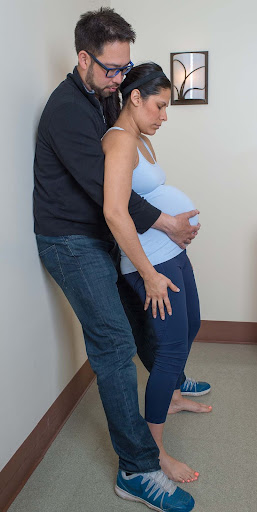
There are signals that a birthing person or their helper can use to help the baby enter the pelvis during birth.
Engagement means the widest part of the baby’s head has slipped beneath the top of the pelvis. When a baby engages in pregnancy this is called “lightening”, and indeed, breathing feels lighter. Sometimes people say, “the baby has dropped” because the baby is lower in the body. Fully engaged, the baby’s head is all the way to the halfway point through the pelvis, however, the baby is likely to stay there (or near there) until pushing.
The body gives signals to the birthing person where the baby is moving through the pelvis and these signals can be also perceived in the body of the helper.
Signals Baby is High
Pressure is felt in the lungs and ribs. It is not as easy to take a deep breath or eat more than a small meal.
Signals Baby Has Engaged
You may feel more pressure between your hips as your baby is now in the pelvis. You can eat more but you will also pee more often. You can feel the top of your uterus is now lower than it used to be.
Once Contractions Begin
Contractions can become closer and more regular, and you feel the sensations listed below.
Contractions may stay perfectly regular and perhaps 5 minutes apart for hours and hours (or about 5-6 minutes) with or without pain at the pubic bone or brim areas of the pelvis. Contractions sometimes start very hard and long for only a few hours, then almost stop and become wide apart and mild.
With Ongoing Contractions But Before the Baby has Entered the Pelvis
You might feel some of the following sensations as the uterus works on getting the baby into the pelvis (but you are unlikely to feel all of them):
With Ongoing Contractions After the Baby has Engaged in the Pelvis
The pubic bone pain (if related) is gone now, and you feel more pressure deep in the pelvis.
You may perceive cervical sensations of stretching and thinning. You may also feel the following:
Why Help Baby Engage?
In early labor, once contractions are coming at intervals that are predictable (every 5-6 minutes for example, though this could be every 7 minutes or every 3-4 minutes), you can use a birthing position that opens the pelvic brim so baby can slip into the pelvis.
See more information on how to help rotate a posterior baby before trying to engage the baby in the posterior position.
How To Help Baby Engage
Remember to breathe as freely as the contraction allows. Repeat this for ten contractions in a row. Straighten your back and legs between contractions.
For additional free information on how to help baby engage see our article Abdominal Lift and Tuck.
Parent-Centered Resources to Prepare for an Easier Birth
Babies may not need help to engage (or they still occasionally may) when the body is prepared with supple muscle and joint movements.